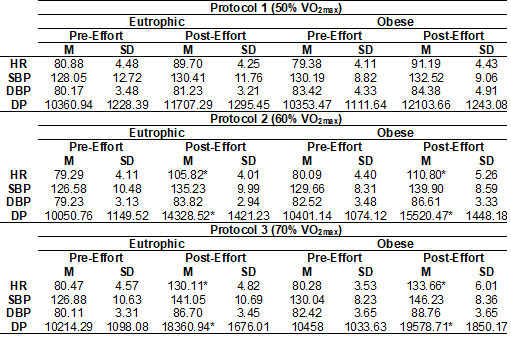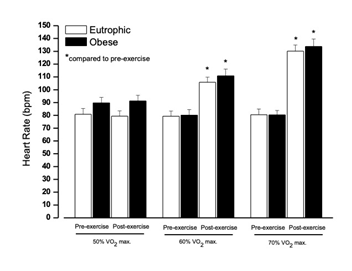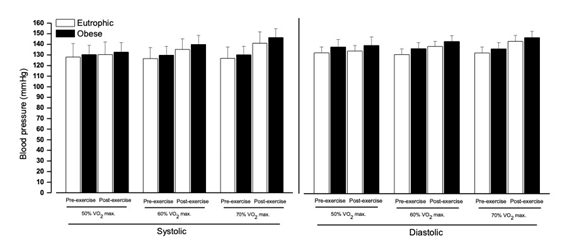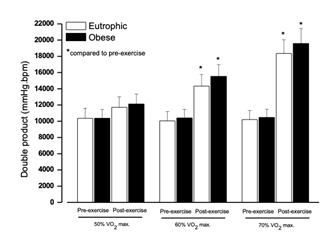Rev Bras Fisiol Exerc 2021;20(4):451-60
doi: 10.33233/rbfex.v20i4.4398
ORIGINAL ARTICLE
Cardiovascular behavior in obese individuals
undergoing different training intensities
Comportamento
cardiovascular em obesos submetidos a diferentes intensidades de treinamento
Jucilete
Coelho Ferreira1, Rodrigo Tavares Dantas2, Nilson Vieira
Pinto3
1Instituição Federal de Educação, Ciência
e Tecnologia do Ceará, Campus Canindé, CE, Brasil
2Hospital Dr. Carlos Alberto Gomes
Studart, Governo do Estado do Ceará, Fortaleza, CE, Brasil
3Instituto Federal de Educação, Ciência e
Tecnologia do Ceará, Campus Fortaleza, CE, Brasil
Received: October 1, 2020; Accepted: June 5, 2021.
Correspondence: Nilson Vieira Pinto, Av. Treze de Maio, 2081, 60040-531 Fortaleza CE
Jucilete Coelho Ferreira:
jucilete13@gmail.com
Rodrigo Tavares Dantas: dantasrt@gmail.com
Nilson Vieira Pinto: nilsonvieira@ifce.edu.br
Abstract
Objective: This study aimed to evaluate the
cardiovascular behavior in obese individuals submitted to different intensities
of aerobic training on a treadmill. Methods: Seventeen eutrophic and 20 obese
individuals were selected, classified by body mass index. The VO2max
was evaluated through the Bruce Protocol Stress Test and the sample was
submitted to an aerobic training protocol with speeds equivalent to 50%, 60%
and 70% of the VO2max for the cardiovascular behavior evaluation. Results:
The results showed significant differences in the chronotropic parameters and
the double product, in the protocols of 60% and 70% of the VO2max,
however indifferent compared between the groups. There were no significant
blood pressure changes between groups. Conclusion: there were no
differences in the cardiovascular behavior of obese individuals about eutrophic
individuals evaluated in this study, submitted to different aerobic training
protocols.
Keywords: obesity; exercise; endurance
training.
Resumo
Objetivo: Este estudo teve como objetivo avaliar
o comportamento cardiovascular em obesos submetidos a diferentes intensidades
de treinamento aeróbico em esteira ergométrica. Métodos: Foram
selecionados 17 indivíduos eutróficos e 20 obesos,
classificados pelo índice de massa corporal. O VO2máx foi avaliado
através do teste de Bruce e a amostra submetida a protocolo de treinamento
aeróbico com velocidades equivalentes a 50%, 60% e 70% do VO2máx
para avaliação do comportamento cardiovascular. Resultados: Os
resultados mostraram diferenças significativas dos parâmetros cronotrópicos e
no duplo produto, nos protocolos de 60% e 70% do VO2máx, todavia
indiferentes quando comparadas entre os grupos. Não houve alterações
pressóricas significativas entre os grupos. Conclusão: Não houve
diferenças no comportamento cardiovascular dos obesos em relação aos eutróficos avaliados neste estudo, submetidos aos
diferentes protocolos de treinamento aeróbico.
Palavras-chave: obesidade; exercício físico; treino
aeróbico.
Introduction
Obesity is a
problem that affects low and middle-income countries, both sexes and all age
groups. It is specifically caused by the imbalance between caloric consumption
and energy expenditure, being considered a multifactorial disease that causes
high costs for public health [1]. When associated with a sedentary lifestyle,
it can cause serious damage to health, besides promoting limited motor performance
and frequently increasing the chances of developing several chronic diseases.
Excessive accumulation of body fat impairs the functioning of the
cardiovascular and respiratory systems, negatively influencing health-related
physical fitness, in addition to enabling the development of cardiovascular
diseases [2].
These diseases
cause heart and blood vessels disorders and are responsible for high mortality
rates worldwide [3]. Ishitani et al. [4] point
out cardiovascular diseases as the leading cause of death in Brazil, aggravated
by the absence of a healthy lifestyle, with cerebrovascular diseases,
myocardial ischemia, and hypertension being the most common.
For Santa-Clara et al. [5], the
practice of physical activities, besides being a very effective treatment that
does not demand high economic costs, is also capable of sharply reducing
mortality rates from cardiovascular diseases and improving the quality of life
of practitioners. Sasaki and Santos [6] report that aerobic exercise is one of
the most efficient non-pharmacological methods for preventing disorders
involving the cardiovascular system. In addition, Arruda et al. [7] add
that aerobic training can promote a significant weight reduction of its
practitioners.
The practice of
aerobic exercises triggers a series of physiological adaptations in the human
body, mainly affecting the circulatory system [8]. They can present from acute
responses, which are those observed during the performance of the activity, to
chronic responses that only appear after a few exercise sessions [9].
From this, Sousa
et al. [2] stated that the heart of an obese individual undergoes
several changes in its structure. For this fact, they need a more detailed
cardiorespiratory assessment. Thus, the analysis of probable cardiorespiratory
limitations in overweight people during aerobic training on a treadmill, based
on an essential health status indicator, can broaden the understanding of
cardiovascular behavior in these relationships, supporting reflections and
safer strategies and efficient in combating obesity.
Given these
factors, this research aimed to evaluate the acute cardiovascular behavior in
obese individuals undergoing different intensities of aerobic training on a treadmill.
Methods
This is a
cross-sectional field study with a quantitative approach, consisting of a
sample of 37 individuals, of both sexes, 20 obese,
with a mean age of 26.7 ± 5.73 years, (five men and 15 women) and 17 eutrophic,
with a mean age of 28.29 ± 7.77 years (seven men and ten women). This study
followed the norms that regulate research on human beings of the National
Health Council - Ministry of Health, Resolution No. 510/2016 and was approved
by CEP/IFCE under opinion no. 2.823.010.
Participants in
this research were obese subjects, who had body mass index (BMI) equal to or
greater than 30 kg/m², and eutrophic subjects (control group), who had BMI
equal to or below 25 kg/m², aged over 18 years, who did not present
comorbidities and/or diseases limiting ergometric exercise and had been
assiduous in the gym for a minimum of three months. Those who did not meet the aforementioned inclusion criteria, those with cardiovascular
diseases limiting exercises such as ischemia and cardiac arrhythmias, those who
used drugs, those who were absent from any evaluation stage, and those who did
not accept participation in the study were excluded from this research.
Among the obese,
14 (70%) had a BMI between 30 and 34.9 kg/m², classified as grade I obesity, 5
(25%) between 35 and 39.9 kg/m², with grade II obesity and one volunteer (5%)
above 40 kg/m², grade III obesity. The eutrophic presented an average of 23.63
(± 0.96) kg/m². These parameters follow the norms established by the World Health
Organization [10].
Body composition
was evaluated by calculating the BMI, obtained through the quotient of body
mass (in kg) by the square of height in meters (kg/m2). The weighing
was performed with the subjects barefoot and wearing light clothing, using an
Omron body control scale, model HBF-514C, with a capacity to record 150 kg,
using the tetrapolar bioelectrical impedance method, following the protocol
described by Machado et al. [11].
The maximum
aerobic capacity (VO2max) evaluation was performed through the Bruce
test on a treadmill model KT 10200 ATL, which aimed to establish the percentage
of intensity applied during the experimental protocol. Heart rate (HR) was
continuously recorded using a Polar heart rate monitor, Vantage NV model.
Based on the VO2max
determination, the groups were submitted to a training protocol performed on a
treadmill, without inclination, at a speed equivalent to 50%, 60%, and 70% of
VO2max, for 10 minutes. All (obese and eutrophic) were submitted, in
a randomized order, to different aerobic training intensities, on different
days, with 24-hour intervals, performing a different protocol each day. To
calculate the speed on the treadmill that could be used for both walking and
running without incline, and thus to facilitate the control of speed on the
treadmill during aerobic exercise, the regression equation was used: Speed (km/h)
= 1.8182 + 0.2266 x VO2max proposed by Dos Santos [12].
The
cardiovascular behavior assessment was performed by analyzing the HR, blood
pressure (BP), and the double product (DP) of these individuals. The
measurement of cardiovascular parameters was performed before and after each
training protocol. HR was assessed using a digital frequency meter, BP using
the auscultatory method, and DP through a mathematical calculation, multiplying
HR by systolic blood pressure.
For data
analysis, individuals were initially grouped according to gender, age and BMI, and then a comparison between the groups was
performed. From this, the results were tabulated in an Excel spreadsheet
(Windows Office 2016), then analyzed using SPSS software - Statistical Package
for Social Sciences - version 20.0, expressed as mean and standard error of the
mean. The level of significance established was p < 0.05.
Results
The results
showed no statistically significant difference between the means of eutrophic
compared to obese in the parameters of cardiovascular behavior evaluated in
protocol 1 (50% of VO2max). However, they showed significant (*p
< 0.05) chronotropic and double product differences in protocols above 60%
of VO2max when compared to their mean pre-effort values, being
statistically indifferent when comparing these responses between eutrophic and
obese (Table I).
Table I - Cardiovascular
behavior of the sample in different exercise protocols

HR = Heart rate; SBP =
Systolic blood pressure; DBP = Diastolic blood pressure; DP = Double product; M
= Mean; SD = Standard Deviation; *p < 0.05
When comparing
the absolute values of HR pre and post-protocol 1, we
can observe that the eutrophic group presented a difference of 8.82 bpm (9.83%)
and the obese group 11.81 bpm (12.95%). Thus, the absolute difference due to
the increase in intensity in the VO2max in this protocol was 2.99 bpm
for the obese group in relation to the eutrophic group. In this trajectory, it
can be observed that the eutrophic group presented a difference of 26.53 bpm
(25.07%) and the obese group of 30.71 bpm (27.71%) in protocol 2. Thus, the
group of obese individuals presented an absolute difference of 4.18 bpm
compared to eutrophic individuals. In protocol 3, it is observed that the
eutrophic group presented a difference of 49.64 bpm (38.15%) and the obese
group of 53.38 bpm (39.93%), an absolute difference of 3.74 bpm for the obese
group compared to the eutrophics evaluated.
Graph 1
illustrates this chronotropic increment and highlights heart rate performance
compared to pre-exercise values (p < 0.05).

Source: Prepared by the
author
Graph 1 - Heart rate
analysis
When comparing
the mean absolute values of SBP pre- and post-protocol 1, it can be observed
that the eutrophic had a difference of 2.36 mmHg (1.80%) and the obese 2.33
mmHg (1.75%), an increase practically similar between the groups. Similarly,
when comparing the mean DBP values obtained before and after training, there is
a difference of 1.06 mmHg (1.30%) for eutrophics and 0.96 mmHg (1.13%) for the
obese.
However, when
comparing the absolute values between pre and
post-protocol 2, eutrophic individuals showed a difference of 8.65 mmHg (6.39%)
and obese individuals a difference of 10.24 mmHg (7.21%), demonstrating an
absolute difference of 1.55 mmHg between obese and eutrophic individuals. When
observing the DBP, the eutrophic individuals showed a difference of 4.59 mmHg
(5.57%) and the obese 4.09 mmHg (4.72%), an increase in blood pressure without
significant relationships, especially when compared with each other.
In the pressure
evaluation of protocol 3, the eutrophic individuals showed an absolute
difference of 14.17 mmHg (10.04%) and the obese group of 16.19 mmHg (11.07%)
after training concerning the initial state. When compared to each other, these
groups did not show a statistically significant difference. In the analysis of
DBP, there is a difference of 6.59 mmHg (7.60%) in the eutrophic group and 6.34
mmHg (7.14%) in the obese group, a greater response when compared to the
protocols above, but still without a significant difference when compared
between groups.
Graph 2 illustrates
the pressure variations in the different intensity protocols and highlights the
performance of systolic and diastolic blood pressure in the comparison between
groups and pre-exercise values.

Source: Prepared by the
author
Graph 2 - Blood pressure
analysis
When comparing
the pre and post-protocol 1 DP data, it is observed
that the eutrophic group presented a difference of 1346.35 mmHg.bpm
(11.50%) and the obese group of 1750.19 mmHg.bpm
(14.46%). An absolute difference of 403.84 mmHg.bpm
of obese compared to eutrophic. Although a difference is perceived in the
analysis of the absolute values of protocol 1, as well as in the chronotropic
and pressure analyses, the double product did not present a significant
difference between the groups in this percentage of intensity.
However, in
protocol 2, it was noticed that both eutrophic and obese individuals showed
statistically significant differences between post-training and pre-training,
although they did not show statistical differences when compared to each other.
When comparing the pre and post-training values, the
eutrophic showed a difference of 4277.76 mmHg.bpm
(29.85%) and the obese 5119.33 mmHg.bpm (32.98%), a
difference of 841.57 mmHg.bpm of obese individuals
about the eutrophic group.
Similarly, the
analysis of protocol 3 showed that both eutrophic and obese individuals
presented statistically significant differences between the mean values
obtained in the post-training comparing to the pre-training. However, they were
indifferent when compared to each other. In this analysis, eutrophic
individuals showed a difference of 8146.65 mmHg.bpm
(44.36%), and obese individuals showed a difference of 9120.71 mmHg.bpm (46.58%). With that, the obese presented a
difference of 974.06 mmHg.bpm, when compared to the
eutrophic ones.
Graph 3
illustrates the changes in the double product in the different intensity
protocols and highlights the cardiac work comparing between groups and
pre-exercise values (p < 0.05).

Source: Prepared by the
author
Graph 3 - Analysis
of the double product
Discussion
This study
evidenced a similar cardiovascular behavior among the eutrophic compared to the
obese evaluated, although presenting significant differences in the
chronotropic and double product parameters, in the protocols from 60% of the VO2máx,
compared to each other.
Corroborating
our findings, Souza et al. [2] compared obese and non-obese sedentary
individuals undergoing treadmill testing and did not identify differences in
chronotropic and double product responses. These authors point out that HR is a
variable that depends on exogenous factors and, in
addition, obesity requires a probable adaptation of the intrinsic cardiac
innervation, which may justify these similar cardiovascular behaviors between
the groups and our results.
Santos and
Ribeiro [13] evaluated the cardiovascular behavior in the pediatric exercise
test on a cycle ergometer among eutrophic and obese children, highlighting HR
as the only variable that showed a difference between the groups and only in
the last stage of the test, with no changes significant in pressure responses
and the double product. These authors suggested that this result may be related
to a possible redirection of blood flow in favor of thermoregulation and the
sympathetic response given mainly by the obese.
Also, along this
line, Barbosa et al. [14] compared the double maximum product (DPmax) of aged people with different body mass indexes
(BMI) and demonstrated that the BMI of the elderly does not influence the
result of the DPmax obtained in the effort test with
the Bruce protocol. They evidence that although there is a direct association
between BMI and the increase in HR and SBP, these increases do not have enough
impact on the DPmax, as seen in our results.
Thus, it is
noted that factors such as the level of physical fitness, body temperature, and
chronological age can influence the cardiovascular behavior of obese patients.
However, these parameters were not analyzed in our study.
Nevertheless,
Aquino [15], when evaluating the pressure responses in the protocols of 50%,
70%, and 90% of VO2max, noticed that only training on the treadmill
with an intensity of 90% of VO2max presented a statistically
significant pressure difference, suggesting that only high-intensity activities
can promote significant pressure changes, which would justify the pressure
behavior found in our study.
In contrast to
our findings, Gustafson et al. [16], when investigating morbidly obese
women, showed that plasma catecholamines showed a significantly smaller
increase in obese women. They argue that obesity constitutes a hyperinsulinemic and hypoadrenergic
state, thus reducing the cardiovascular response and promoting a reduction in
metabolic activity, contributing to exercise intolerance, a characteristic of
the sedentary individual with excess weight. However, this study promoted an
investigation under a classificatory relationship of morbidity and in sedentary
women, characteristics that are different from our study.
Afferent
information of central and peripheral origin during exercise promotes the
adjustment of physiological functions to the cardiovascular system, causing the
skeletal muscle to receive sufficient oxygen and necessary nutrients during
muscle contraction. Therefore, all changes observed during exertion are
associated with the intensity with which it occurs. These changes are modulated
by the autonomic nervous system on the circulatory system and are directly related
to the increase in sympathetic activity and inhibition of parasympathetic
activity [17]. This occurs because muscle contraction activates chemoreceptors
and muscle and joint mechanoreceptors, and this mechanism ends up causing the
cardiovascular behavior to change gradually [18].
The
cardiovascular behavior identified in this study, reflecting the chronotropic
increment promoted by the HR with the increase in intensity, and consequently
by the DP, represents the physiological response of the body submitted to
effort to meet the metabolic need of that intensity moment.
It is noteworthy
that the obese group showed cardiovascular behavior like the eutrophic group in
the intensity protocols evaluated. However, it is necessary to recognize the
similar sample characteristics between the groups, such as age, height, and,
probably, the level of physical fitness, since they are regular practitioners
of physical activities. These relationships can promote adaptive responses that
reflect similar cardiovascular behavior between obese and eutrophic
individuals.
Thus, these
findings lead us to recognize that in the case of trained young adults, obese,
without associated comorbidities, aerobic training protocols can be established
at a constant pace with the same relationships established for eutrophic
individuals.
Among future
investigative possibilities, the intensity percentages expansion to 80% and 90%
of VO2máx can be listed, as well as the evaluation in other aerobic
training protocols and their relationship with resistance and/or intermittent
training.
Finally, a vast
and current approach is identified around aerobic training in obese children
and adolescents and comorbidities associated with obesity. However, there is
still a limited scientific production that addresses cardiovascular responses
in obese patients undergoing aerobic training at a steady pace, especially with
characteristics like our sample, which limited us to the bibliographic
strengthening of this discussion.
Conclusion
There were no
differences in the cardiovascular behavior of obese individuals about eutrophic
individuals evaluated in this study, submitted to different aerobic training
protocols on a treadmill.
Conflict of interest
No conflict of interest
with relevant potential.
Financing source
There were no external
funding sources for this study.
Author’s contributions
Conception and design
of study: Pinto, NV. Acquisition, analysis and/or interpretation of
data: Pinto, NV, Ferreira JC, Dantas,
RT; Drafting the manuscript: Pinto, NV, Ferreira JC; Revising the
manuscript critically for important intellectual content: Pinto, NV, Dantas, RT.
References
- Wannmacher
L. Obesidade como fator de risco para morbidade e mortalidade: evidências sobre
o manejo com medidas não medicamentosas. Organização Pan-Americana de
Saúde/Organização Mundial de Saúde [Internet]. 2016 [cited 2021
Aug 3];1(7):1-10. Available from:
https://www.paho.org/bra/dmdocuments/Fasciculo%207.pdf
- Souza
F, Navarro AC, Stancati Filho J, Serra MM, Alonso AC.
Repostas cardiorrespiratórias de indivíduos sedentários obesos e não obesos em
esteira ergométrica. Revista Brasileira de Prescrição e Fisiologia do Exercício
[Internet]. 2014 [cited 2021 Aug
3];8(44):164-71. Available from:
http://www.rbpfex.com.br/index.php/rbpfex/article/view/602/560
- Carlucchi
EMS, Gouvêa JAG, Oliveira AP, Silva JD, Cassiano ACM, Bennemann
RM. Obesidade e sedentarismo: fatores de risco para doença cardiovascular. Comun Ciênc Saúde [Internet]. 2013
[cited 2021 Aug 3];375-384. Available from:
http://bvsms.saude.gov.br/bvs/artigos/ccs/obesidade_sedentarismo_fatores_risco_cardiovascular.pdf
- Ishitani
LH, Franco GC, Perpétuo IHO, França E. Desigualdade social e mortalidade
precoce por doenças cardiovasculares no Brasil. Rev
Saúde Pública 2006;40(4):684-91. doi: 10.1590/S0034-89102006000500019 [Crossref]
- Santa-Clara
H, Pinto I, Santos V, Pinto R, Melo X, Almeida JP, et al. Atividade física e
exercício físico: especificidades no doente cardíaco. Revista Factores de Risco [Internet]. 2015 [cited 2021
Aug 3];28-35. Available from: https://core.ac.uk/download/pdf/71739097.pdf
- Sasaki JE, Santos MG. O papel do exercício aeróbico sobre a função endotelial e sobre os fatores de risco cardiovasculares. Arq Bras Cardiol 2006;87(5):e226-e231. doi: 10.1590/S0066-782X2006001800036 [Crossref]
- Arruda
DP, Assumpção CO, Urtado CB, Dorta LNO, Rosa MRR, Zabaglia R, et al. Relação entre treinamento de força e
redução do peso corporal. Revista Brasileira de Prescrição e Fisiologia do
Exercício [Internet] 2010 [cited 2021 Aug 3];4(24):10. Available from:
http://www.rbpfex.com.br/index.php/rbpfex/article/view/291/293
- Cruz AP, Araújo SS, Dos Santos JR, Leão AS. O efeito hipotensor do exercício aeróbico: uma breve revisão. Rev Bras Ciênc Saúde 2011;15(4):479-86. doi: 10.4034/rbcs.2011.15.04.15 [Crossref]
- Kura
GG, Filho, HT. Adaptações agudas e crônicas dos exercícios resistidos no
sistema cardiovascular. Lecturas Educación
Física y Deportes (Buenos Aires) [Internet]. 2011 [cited
2021 Aug 3];15:1-9. Available
from: https://www.efdeportes.com/efd153/adaptacoes-agudas-e-cronicas-dos-exercicios-resistidos.htm
- World Health Organization. Obesity: preventing and
managing the global epidemic. Report of a World Health Organization
Consultation. Geneva: World Health Organization, p. 256. WHO Obesity Technical
Report Series, n. 284; 2000 [Internet]. [cited 2021 Aug 3]. Available
from: http://www.who.int/nutrition/publications/obesity/WHO_TRS_894/en/
- Machado
AF, Abad CCC. Manual de Avaliação Física. 2 ed. São Paulo: Ícone; 2012.
- Santos
MAA. Análise da precisão e da aplicabilidade do consumo de oxigênio de reserva
durante o exercício aeróbio contínuo nas intensidades de 50% a 80% do consumo
máximo de oxigênio [Internet] [Tese]. Vitória: Universidade Federal do Espírito
Santo; 2007 [cited 2021 Aug
3]. Available from:
http://repositorio.ufes.br/bitstream/10/5168/1/tese_3247_Tese%20Miguel%20Alves%20dos%20Santos.pdf
- Santos
JAB, Ribeiro SML. Avaliação da resposta cardiovascular a um teste de esforço em
crianças obesas: discussão do uso do duplo produto. Brazilian
Journal of Sports and Exercise Research [Internet]. 2010 [cited 2021 Aug
3];1(1):31-6.
- Barbosa
TA, Diogo DP, Petto J. Comparação entre o duplo produto de idosos com
diferentes índices de massa corpórea. Rev Bras Fisiol Exerc
2013;12(3):159-62. doi: 10.33233/rbfe.v12i3.3328 [Crossref]
- Aquino
MS. Análise da pressão arterial sistêmica incremental em esteira nas
intensidades: 50%, 70% e 90% do VO2máx [Internet] [Monografia].
Brasília: Faculdade de Ciências da Educação e Saúde da UniCEUB;
2015 [cited 2021 Aug 3]. Available from: https://repositorio.uniceub.br/jspui/bitstream/235/7498/1/21112322.pdf
- Gustafson AB, Farrell PA, Kalkhoff RK. Impaired plasma catecholamine response to submaximal treadmill exercise in obese women. Metabolism 1990;39(4):410-17. doi: 10.1016/0026-0495(90)90257-D [Crossref]
- Silva
VDR, Sant’ana JE, Vanderlei LCM, De Carvalho AC.
Análise do comportamento dos parâmetros cardiovasculares durante a realização
de exercícios físico sem hemiplégicos crônicos. Arq Ciênc Saúde [Internet]. 2006
[cited 2021 Aug 3];13(4):181-5. Available from:
http://repositorio-racs.famerp.br/racs_ol/vol-13-4/Famerp%2013(4)%20ID%20182%20-%2011.pdf
- Rodrigues
MC. Alterações de parâmetros cardiovasculares e envolvimento dos receptores AT2
na CVLM sobre pressão arterial, induzidas por atividades de baixa intensidade
em ratos com hipertensão renovascular [Internet] [Dissertação]. Minas Gerais:
Programa de Pós-graduação em Ciências Biológicas da Universidade Federal de
Ouro Preto; 2007 [cited 2021 Aug
3]. Available from:
https://www.repositorio.ufop.br/handle/123456789/2671